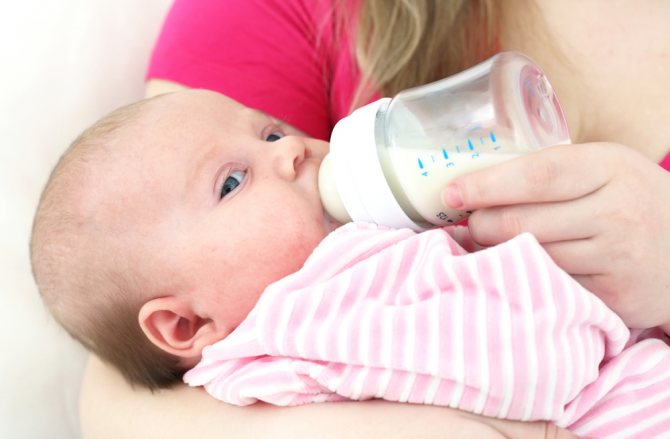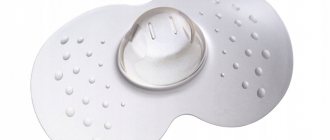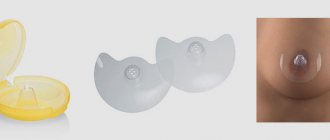The child must necessarily receive the mother’s breast to strengthen the immune system, better growth and rapid development. Weaning from breastfeeding is an obligatory stage in the life of a baby. Only the mother herself can decide how to wean her child off breastfeeding.
Weaning can occur for a number of reasons, including the mother's fatigue from constant feeding, pain, the need to go to work, or pressure from others due to the fact that feeding has been delayed for a long period.
In order for weaning a child from breastfeeding to go quickly and painlessly, you need to do it correctly and gradually, focusing on your own feelings.
When to wean?
How to wean off breastfeeding easily depends largely on the age of the baby. When to stop breastfeeding, the mother herself must decide, but there are many opinions that will help you quickly decide on the period:
- Most pediatricians are confident that a child should be breastfed for at least a year. A one-year-old baby tolerates weaning more easily, and the likelihood of unpleasant consequences for the mother is significantly reduced;
- Doctors agree that it is necessary to wean a child from the breast at 1.5 years. It is at this age that he is able to independently consume other types of food, so there is no need for constant breastfeeding. You cannot wean abruptly so as not to cause psychological trauma to the baby. The transition should be gradual, and most breastfeedings should begin to be replaced with regular food;
- If the child is older than 1.5 years, then it will be much more difficult to wean him. At this age, breast milk is not a source of food, but a way of comfort, distraction and time. Therefore, the question of how to wean from breastfeeding after a year arises more acutely. Solving this problem will require a lot of physical as well as psychological endurance from the mother;
- Among doctors there are supporters of natural weaning from breastfeeding. They believe that weaning a baby from the constant demand for breast milk does not make sense, because 1.5 years after birth, the mother’s body will independently reduce production, and the need to feed on demand only indicates that the baby is not ready to completely forget about the breastfeeding method or comfort. . A month or a little longer after the reduction in milk production, the baby will refuse.
WHO believes that weaning should only occur after the age of two. This is especially true for countries where infectious diseases are widespread. These include Russia.
How to wean from breastfeeding and not harm the baby largely depends on the time of year. Abrupt refusal of breast milk in summer and heat can negatively affect the body.
It is at this time that infections actively multiply, which increases the risk of gastrointestinal diseases, even if all hygiene standards are observed. This also applies to the period of seasonal colds. With the refusal of mother's milk, the baby loses additional support for the immune system, which increases the risk of illness several times.
Until what age should you breastfeed?
There is no consensus among experts regarding the duration of breastfeeding. Some pediatricians believe that breastfeeding after a year is not advisable, others stop at the age of a year and a half, and supporters of radical views believe that a child can regularly breastfeed for as long as he wants.
The general opinion is that until four to six months the child should not receive anything other than mother's milk. At the age of 9 months - 1.5 years, when weaning most often occurs, mother's milk is still beneficial for the child. It still has protective and anti-infective properties. It contains substances that stimulate brain maturation, as well as enzymes that promote food digestion, etc. Children who have been breastfed for a long time are less likely to get sick in the future, adapt better to children's groups, and, according to some studies, have higher intellectual capabilities. Finally, and very importantly, the process of breastfeeding itself supports and complements the physical and psychological contact between mother and her baby.
In addition, long-term lactation is also beneficial for women: it reduces the risk of breast cancer.
Signs that baby and mother are ready to wean
How to properly wean a child from constant breastfeeding? To do this, you need to focus only on his condition and your own feelings. Doctors' opinions about the age at which breastfeeding ceases vary significantly.
This is due to the fact that each baby is different and can be identified by certain signs:
- the baby needs 1-3 feedings per day (before or after sleep), he calmly falls asleep with another person, for example, dad;
- the breast ceases to be a way of comfort;
- the child can be easily distracted from it with toys or other means;
- there is no need for breast milk after another type of food;
- the child behaves calmly during the mother’s absence, calmly falls asleep, eats and does not require breastfeeding from another person (grandmother, father);
- The baby has refused the pacifier and does not suck his fingers, fists or bottles.
How to wean a child from breastfeeding a baby after a year is of great concern to those mothers who are strongly attached to their baby. Especially if it is related specifically to the feeding process. Many mothers, due to psychological denial of the baby’s real age, cannot give up natural feeding in time.
The main sign that the mother is ready to stop breastfeeding is the ability to realize that the need to fully protect the baby from viruses through breastfeeding has disappeared. Also, the mother’s readiness may be indicated by unpleasant sensations during the entire process, sometimes causing pain.
If the mother herself understands that she is not yet ready to stop breastfeeding naturally due to psychological factors or pain from constant breast swelling, then you should wait a little. You should not pay attention to pressure from friends or relatives; the baby himself will refuse milk when the time comes.
Weaning methods
The method of weaning a child from breastfeeding largely depends on how much time the mother is willing to spend on this process. All methods differ not only in the time spent, but also in the damage that can be caused to the mother and her offspring.
Grandma's way
Sometimes there is a need to quickly wean the baby from constantly receiving mother’s milk, but in this situation it is necessary to take into account that at this moment the baby is subjected to serious stress due to the lack of possibility of gradual adaptation.
Among the reasons for abrupt weaning from mother's milk are:
- constant fatigue during feeding and weakness after it indicates the readiness of the mother’s body to stop producing milk for feeding. Often, due to psychological fatigue, the first two signs are supplemented by the mother’s desire to “hide” from the baby for a while;
- increased sucking activity, especially at the time of decreased milk production. The baby’s actions prevent the mother’s body from completely stopping milk production, which can cause pain;
- involution of the mammary gland.
If such situations arise, it is recommended to use a “folk” method that will simply make the baby quickly forget about breast milk:
- separation from mother for several days. With this method, it is recommended that the mother leave for a couple of days so that the baby does not see her or hear her voice. It is not recommended to use this method if he reacts poorly to strangers and perceives only his mother, otherwise it can cause severe stress;
- Tightening of the breast to prevent milk production. This method is the most dangerous, as there is a risk of developing mastitis. In addition, the woman will experience constant weakness and ailments;
- applying a substance to the chest that will cause visual or taste disgust in the child;
- using various methods of distracting the child, including fairy tale therapy, in which night feeding is replaced with a fairy tale.
It is also recommended to pay more tactile contact with the baby and not wear clothes that expose the breasts, as this will attract the baby’s attention, and he will unconsciously ask to feed him.
In case of sudden weaning and discomfort due to swelling, doctors recommend lightly expressing milk to alleviate the general condition.
Medication method
Just one tablet a day for a certain period of time can suppress the production of prolactin, a hormone that affects lactation. At the same time, there is a gradual decrease in the amount of milk produced, as a result of which the child gradually loses interest.
Most often, doctors recommend this method and prescribe Dostinex to their patients, as it has a gentle effect on the female body. Any drug may cause unwanted effects, such as nausea, headache, insomnia, or dizziness. Don't forget about the possibility of hormonal changes.

Gentle or natural way
This method is the most optimal. It does not have a negative impact on the baby from a psychological point of view, but it is worth preparing yourself for the fact that it will take a long time before completely giving up milk.
The soft method is based on the gradual weaning of the baby from the mother’s breast, for this it is necessary:
- create a specific schedule for when feeding will occur. In this case, you need to refuse the request to give the breast for comfort. It must be replaced with another tactile contact that will allow you to calm down, or try to divert attention to other objects;
- reduce the amount of breastfeeding. Every day you should replace one feeding with milk for another meal. If the baby has difficulty giving up breastfeeding, then the process itself should be extended. Over time, the baby will have to demand the breast only before bedtime;
- Avoid feeding during the daytime. It is best to replace all breast milk intake with regular food, and before naptime, keep the baby occupied, for example, by going for a walk, so that he is significantly tired. After returning, there should be regular food and sleep. If the child does not fall asleep immediately, then he can be distracted by a fairy tale or song;
- Avoid feeding before bedtime if you are over a year old. It is best if every time before bed, instead of feeding, another action is carried out that will help the baby realize that it is time to sleep. This could be as simple as a light rinse in the bathroom with warm water, reading a fairy tale or listening to soothing music. It is also recommended to put the baby to bed with dad for a while so that he is not distracted and falls asleep faster.
Weaning off mother's milk will happen faster and less painfully for the baby if he is busy with something throughout the day. Constant games and long walks will help your child get tired throughout the day and fall asleep faster.
Choose the right weaning strategy
For a healthy child, weaning from the breast with a timely and gradual increase in complementary foods is easy. By the age of ten months, the baby already receives complementary foods three times and breast milk twice, usually in the morning and evening feedings. In principle, this feeding regime can be maintained for a longer period of time, for example up to a year or more. With regular breastfeeding, milk continues to be produced, despite the fact that the baby receives several types of complementary foods.
Before you start weaning your baby, you should have a clear idea of what you want to achieve in the end. If you plan to go to work, then most likely you will have free evening hours, which you can devote to your baby and put him to your breast. In this situation, it is better to start weaning with morning feeding. If the morning hours are free, start weaning with evening feeding. If you don't care which feeding to start with, it is better to change one of the daily feedings first. This is due to the fact that in the evening hours, when the mother is not in a hurry, it is easier for her to be alone with the baby. In addition, having had enough, the child usually falls asleep immediately, and the traditional evening problem of “putting the baby to sleep” is solved by itself. Before feeding, give your child 50 grams of formula (children under 8 months) or baby kefir (children over 8 - 9 months), then apply to the breast and supplement. It is better to feed your baby from a cup or spoon rather than using a bottle. Over the course of 2 - 3 days, increase the amount of mixture or kefir to 100 - 150 g. So gradually replace all morning feedings. After some time, start supplementing your baby during evening feedings. Do not rush to cancel it, because during this time the baby not only receives healthy food, but also communicates closely with you.
With such gradual weaning, the mother's milk gradually becomes less and less and finally disappears altogether. With a gradual, smooth cessation of breastfeeding, this process may take more than one month. If weaning is rushed, you may stop producing milk within a few days. When there is still a lot of milk, it is necessary to bandage the breast tightly. It's done like this.
Immediately before bandaging, express the milk. Place a thick layer of cotton wool above and below the chest, then tighten the chest with a wide bandage. Do not remove the bandage for several days. If your breasts become swollen, express some milk. Gradually the milk will disappear. During this period, a woman needs to limit her fluid intake as much as possible. In some situations, it is necessary to resort to medications: laxatives and drugs that affect the hormonal status of a woman. You should consult your doctor regarding their use.
However, there are situations when, for some reason, it is necessary to wean the baby early, for example, if the mother needs to go to work full-time, and the baby is only a few months old. In this case, it is advisable to accustom the child to bottle feeding with expressed milk or formula 5-7 weeks in advance. If the baby has already grown up, he may be reluctant to suck from the bottle that his mother gives him, expecting something different from her. In this case, there will be less difficulty if someone else offers the bottle. Make sure your baby sucks at least 50 g from the bottle, then breastfeed him until he is completely saturated. Gradually increase the volume of formula or milk from the bottle to the required volume, first replacing one daily feeding. After a few days, begin replacing the other daytime feedings, and so on, until complete weaning. Replace the evening feeding with the last one. Try to keep it for as long as possible. During weaning, pay a lot of attention to the child, play with him, pick him up more often, cuddle him. Then the baby will not be deprived of closeness with his mother, and the weaning process will be more calm and comfortable for both of you.

You should not stop breastfeeding if your baby is sick, especially with acute intestinal disorders, since mother’s milk is the best and safest medicine for him in this case. It is better not to stop breastfeeding in the summer, especially in the heat. Do not wean your child from the breast immediately after vaccination, because at this time the child’s body is most susceptible to infections.
If your one-and-a-half-year-old or even two-year-old baby is used to latching on to his mother’s breast during the day or at night, but you are quite tired of it, and there is practically no milk anymore, you can try to distract the child with play, affection, or just give him some water to drink. At night, you should not give your child kefir, formula, or milk, so as not to reinforce the habit of eating at night. If the baby asks for breastfeeding only at night, try for some time leaving the baby at night in the care of a close person who is well known to him, and during the day communicate with the baby in the same way as always. When all else fails, you can use a rather radical but effective method. Leave the child completely in the care of a family member, such as a grandmother, for a few days.
It should be taken into account that a change in living conditions (including rapid weaning) is a stressful situation for a child. And the smaller the baby, the stronger the impact of this stress. The body stops receiving protective substances from mother's milk, the load on the still immature digestive tract increases, so at this time the risk of impaired motility of the digestive tract, allergic reactions, penetration of pathogenic microorganisms, and weakening of general immunity increases. From a psychological point of view, the child is deprived of close physical contact with his mother. From this point of view, it is easier to wean a six-month-old baby from the breast than an older one, since a grown-up child will endure such a “separation” more difficult: the process of close contact with his mother becomes important for him. Therefore, it will be good if the mother, and not someone else, bathes the child, dresses him and walks with him. The mother should play more with the baby, caress him so that he does not experience the loss so acutely. If you are bottle-feeding, hold your baby close to you as you would when breastfeeding.
What not to do during weaning
Many mothers go too far when they want to wean their baby from the natural way of feeding.
Some methods can cause significant harm to the health of both the baby and the mother. When weaning, you cannot:
- leaving the child with complete strangers during the weaning period. If on the first day, when separated from his mother, the baby is constantly capricious and refuses to eat, then such an “experiment” should be stopped immediately, since the consequences of such stress can be serious;
- take pills to suppress milk production, let her breastfeed. The effect of this type of weaning will not be much, but the likelihood that the drug itself will enter the body along with milk is quite high;
- lubricate the chest with sharp substances, for example, mustard, as the child may be very frightened, and the substance itself will negatively affect the baby’s stomach. In addition, the delicate skin of the breast is easily susceptible to various influences, as a result of which a burn may occur;
- Limit your intake of water or food. The amount of milk produced does not depend in any way on the water you drink, and not eating enough food will only lead to dehydration;
- replace feeding before bedtime with sweet water or computer. This will cause addiction to the baby and harm the teeth and stomach.
During the whole process, if you can’t wean, then you can’t get angry with the child and show him your dissatisfaction. The entire refusal procedure should proceed smoothly, and sometimes with a step back.

Also, do not give in to the whims of a baby who requires the breast only for comfort or entertainment. The baby must understand that the mother is in charge here.
When you can’t wean yourself off guards
There are times when refusal to feed can have a negative impact on the baby's health.
It is advisable to leave mother's milk in the baby's diet:
- during the cold season. At this time, the baby’s likelihood of getting sick increases significantly due to the fact that his immune system is not yet able to fight all viruses, and he will not have the additional protection that milk provides;
- during extreme heat;
- during the baby’s illness or immediately after his recovery. During this period, the baby is already significantly weakened, and mother’s milk allows the immune system to recover and strengthen faster. Emotional connection also plays a significant factor here;
- if teething. Tactile communication with the mother and her milk can distract the baby from unpleasant and painful sensations;
- with significant changes in his life. If you are preparing to move, the mother’s vacation is ending, and the moment of entering kindergarten comes, then it is best to start the weaning process several months before the expected date.

In any of the above moments, milk and the close presence of the mother can improve health and calm.
What to do to prevent lactostasis from starting?
Lactostasis is a stagnant process accompanied by a painful sensation. After lactostasis, a serious illness of an acute or chronic type may occur. If milk stagnation occurs, a woman should consult a doctor within 2 days.
To prevent this process from occurring, you must follow a number of rules:
- feed the baby at his request;
- Do not express milk immediately after feeding if there is no congestion. A woman’s body is designed in such a way that it produces a certain amount of milk that the baby can consume at one time. If you pump immediately, then before the next feeding its amount will increase sharply, which will lead to the opposite effect;
- choose your underwear carefully. The bra should slightly support the breasts, but not squeeze them. It must be removed before going to bed;
- To sleep, choose a position on your back. Lying on her side or stomach, a woman squeezes the milky flows, which creates stagnation;
- alternate different positions for feeding and do not squeeze the breast during the process;
- eat wholesome and healthy foods to prevent milk viscosity from increasing;
- promptly treat cracks and carry out preventive procedures to prevent their occurrence.
The psychological state of the woman also plays a significant role here. During breastfeeding, you need to take care of your condition and be less in stressful situations, and not overexert yourself too much.
Weaning from breastfeeding is always stressful for both mother and baby. The method of weaning and age should be chosen by the mother herself, based only on her own feelings and the condition of the baby. You cannot make decisions only under the pressure of other people, because this can only cause harm.
How to wean a baby in 5 steps?
To wean an older child from breastfeeding, you need to be patient, because you have to act consistently.
Even before the process begins, it is important to consider several points:
- Firstly, nothing will work out without the correct psychological attitude of the mother herself. This is a difficult time and a fair amount of determination will be required from the mother.
- Secondly, the support of the entire family (grandmothers, father of the child, etc.) plays an important role.
- Thirdly, you need to be patient and not force things. Weaning should occur gradually so that the process does not become traumatic for the child. Otherwise, there is a risk that the opposite effect will be achieved. You need to remain friendly and not get angry with the child, while at the same time insisting on your own.
Reducing daily applications
The first step towards weaning yourself from breastfeeding is to reduce your daily feedings. At the same time, it is important to create a “soft” psychological atmosphere for the child. There is no need to provoke images in his mind that are in one way or another related to feeding: this means that you should not change clothes in front of the child, walk in underwear, it is better to wear T-shirts instead of clothes with fasteners, etc.
In the presence of a child, you should also not sit for a long time without doing anything. In the minds of any baby (as well as older children), a mother sitting or lying idle is a direct signal to start feeding. If a woman is constantly on the move (doing some business, etc.), the incentive is much weaker. It is on this feature of the child’s psyche that the so-called technique is based. "moving target" With an active mother, the child asks for the breast much less often. Already at this stage it is important to show determination; if the child asks for the breast, it is necessary to answer that there is no time for this now, but it will be possible to breastfeed after the end of the work. After just a week or two, this will become habitual for the baby, and he will stop asking for the breast frequently.
In a child up to 3-5 years of age, the basis of consciousness is formed by congenital or acquired reflexes. Therefore, it is important to avoid all situations that somehow remind you of feeding. So, if the child is accustomed to the fact that, for example, feeding occurs during telephone calls to the mother, it is better to go to answer the phone in another room, or end the conversation as soon as possible.
If the baby insists on breastfeeding, the mother should first pretend that she did not understand. If this does not help, you should distract the child’s attention and switch it to something interesting. For example, look out the window, read a book. If this does not work, then you should not refuse the child at this moment.
You need to plan your day and your baby’s day so that there is no time left for breastfeeding. It should be filled with games, walks, etc. It is necessary to maintain physical contact with the child without feeding: massage, hugs. It may happen that a child asks for breastfeeding on the street or at a party. In this case, it is better to offer him his favorite food: cookies, fruits, etc.
If we are talking about a one and a half to two year old child, it is not only possible, but also necessary to agree that feedings take place only at home, and only at a certain time. This will help eliminate situations when a child asks for breastfeeding while visiting or in a store. Still, you should not put your child in overly difficult conditions: long walks or trips to the store will lead to the child getting tired. A tired child, of course, will not comply with the agreement.
Daytime sleep without breasts
The first step has been completed, indiscriminate breastfeeding during the day has stopped. The next step on the path to success is putting your baby to sleep during the day without feeding. The easiest way to achieve this is if the mother leaves the house for a while while one of the family members puts the child to bed. The main thing is to remain calm. This will be easier for both the child and the mother herself. If the person who stays with the child shows gentleness and kindness, the child will very quickly get used to the new “scheme”.
The next step should be the mother herself putting the baby to bed. As practice shows, the method of increasing time intervals works effectively. In this case, the mother promises to return now and goes outside the room for a short period of time. Then, after a few tens of seconds, he returns and puts the baby to sleep with the breast. Gradually the time intervals should increase.
It is necessary to tell the child where the mother is going, and the reason for leaving the room should be significant, for example, to prepare food, wash clothes. If a child, without waiting, goes to his mother, he should not swear. It is necessary to explain to the child that he should wait for his mother to return in his bed.
In this way, the child will learn to fall asleep without his mother.
After waking up, the baby may require the breast. In this case, you need to act the same way as in the first step, distract the child with something. Food, drink, interesting activities do not matter.
How to eliminate evening feedings?
The goal is achieved, the child falls asleep and wakes up during the day without feeding. Once this pattern has become stable, you can begin weaning off evening feedings. Moreover, this should be done according to the same scheme. In order for weaning from feeding at night to be as effective, you need to develop some kind of “ritual” of actions before bed (this may include brushing your teeth, telling stories in bed, etc. The last in this chain should be the process of breastfeeding) . Over time, evening feeding will fall out of this series by itself, and the baby will stop asking for the breast.
If we talk about the readiness of the mother’s body to stop lactation, we need to base it on subjective feelings. If the mother feels quite well during the day without feeding (the breasts do not fill, there is no discomfort, pain, etc.), then lactation can be abandoned without any harm.










